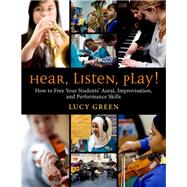Hear, Listen, Play! is a book for all music teachers who are unfamiliar with, yet curious about the worlds of ear-playing, informal learning, improvisation, and vernacular musics. For decades, or even hundreds of years, a divide has slowly been developing between the realms of notation-based musical transmission, and aural/oral methods. Yet that divide is by no means a necessary aspect of music learning, and musicians who are lucky enough to dwell on both sides of it count themselves as so much the richer for doing so. This book aims to provide a door into those other worlds for any teacher who would like to open it.
Starting with a brief discussion of how popular musicians learn in the informal realm, the book then applies many aspects of their learning practices to three main areas within music education. Firstly it tackles the one-to-one specialist instrumental lesson, then ensemble work such as band and orchestra; and finally the generalist or specialist classroom. The methods within each section have been systematically tried and tested in research projects spanning more than a decade, yet the book is written in simple, non-academic language which teachers will quickly find applicable to their working lives. Vignettes from the research participants themselves provide color throughout the book, and give illustrations of how both teachers and learners have experienced the methods themselves.
This book is not a prescription for one particular way of teaching or learning; it does not aim to critique, replace or change the excellent practices that are already on-going in the diverse world of music education and pedagogy. It simply offers something which is likely to be new to many teachers, and which they can, if they so wish, add in to the mix. The professional judgment and expertise of the teacher is surely the lynch-pin on which all good teaching relies; and the open nature of this book, along with its frequent calls for teachers to not only adopt, but adapt, its methods according to their own and their students' needs, is a testimony to that.








